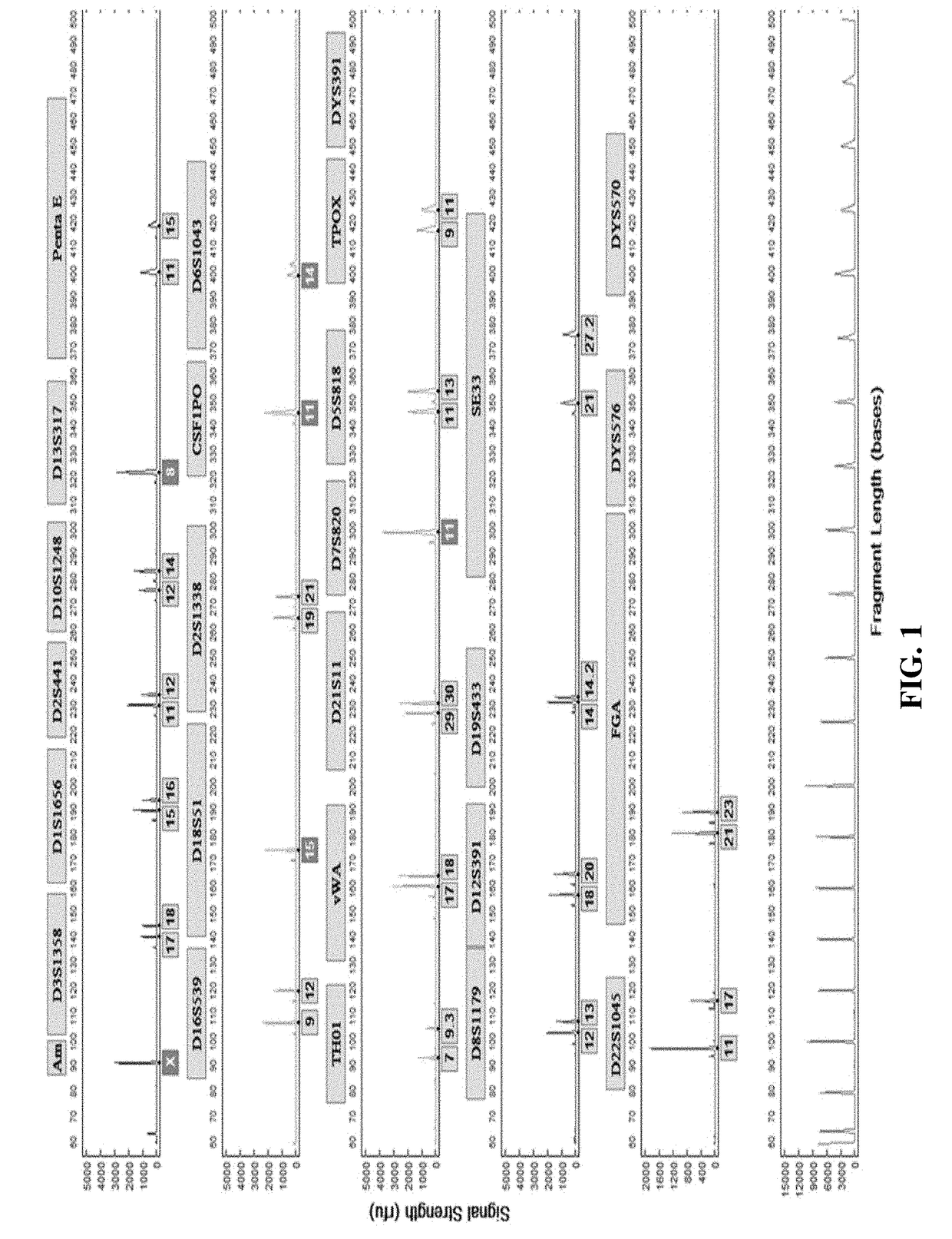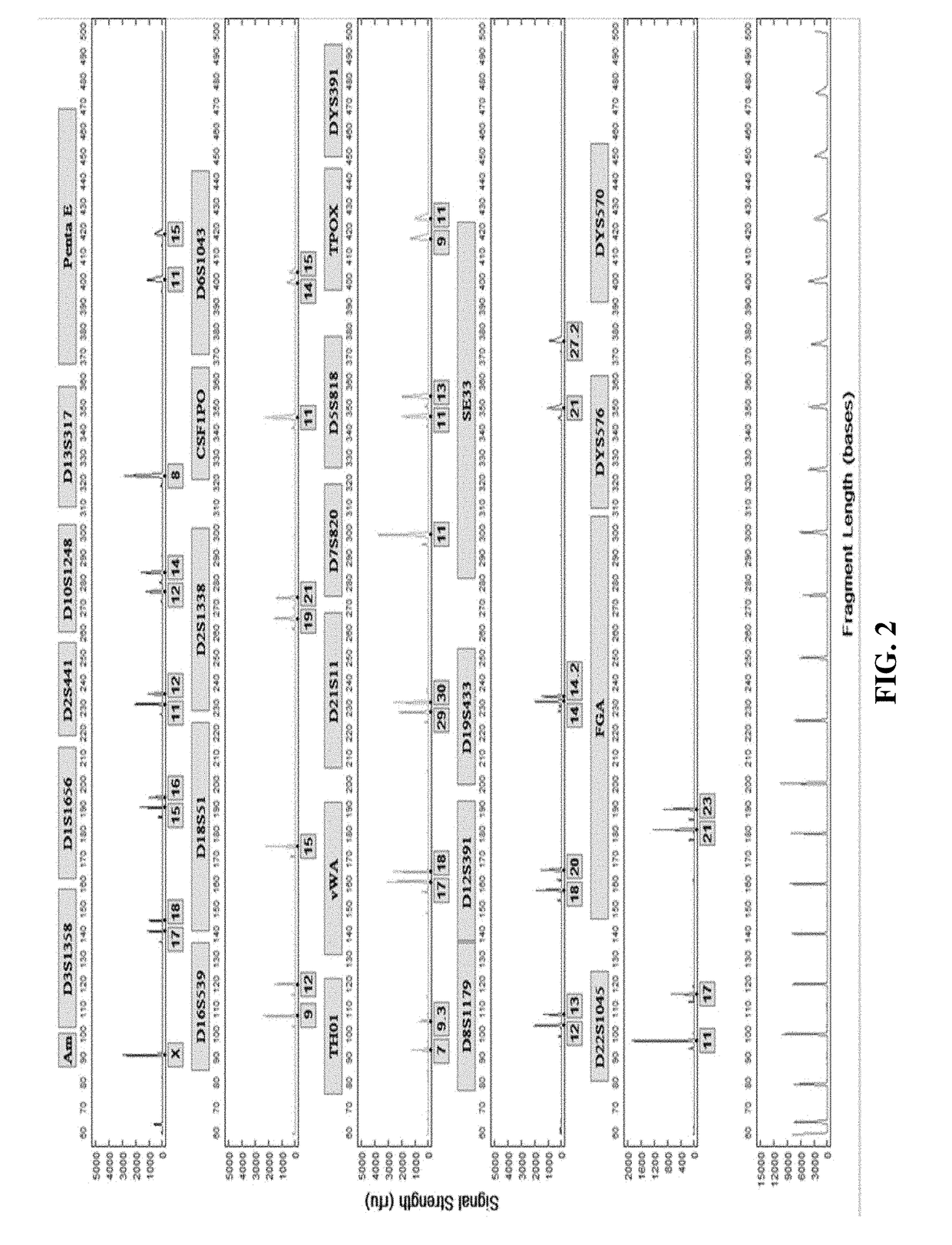Pattern Recognition System
- Summary
- Abstract
- Description
- Claims
- Application Information
AI Technical Summary
Benefits of technology
Problems solved by technology
Method used
Image
Examples
Example
Example 1. AES Analysis Workflow
[0305]FIGS. 10 and 11 are flowcharts that describe how the AES functions:
[0306]1. Sample data (optical signals from the detectors stored in .csv (comma delimited) format, or .dat, (tab delimited) or other compatible formats) or raw electropherogram data (optical data that has been color corrected and is stored in .nbo, or .FSA, or .HID formats) from the ANDE run is imported into the ANDE Database Management System (ADMS) or the ANDE FAIRS application. For example, the optical data or Electropherogram data is transmitted to and stored on the computing device (e.g., via a communications network such as the Internet, or ethernet, or via a removable disk or USB drive).
[0307]ANDE ADMS and ANDE FAIRS are standalone applications that execute on a computing device (e.g., a laptop, or desktop, or server). These applications allow data that is generated on ANDE to be imported, exported, stored, and processed. These applications have instances of the ANDE Expert...
Example
Example 2. Generation of Sample Data for AES Analysis
[0372]Separation and detection of the DNA is carried out on in a chips and instruments in the following U.S. patents herein incorporated by reference: U.S. Pat. Nos. 8,018,593; 8,173,417; 8,206; 974; 9,523,656; 9,606,083; “Ruggedized apparatus for analysis of nucleic acid and proteins,” 9,366,631 “Integrated systems for the multiplexed amplification and detection of six and greater dye labeled fragments,” 8,858,770; 8,961,765; 9,994,895 “Plastic microfluidic separation and detection platforms.”
[0373]The separation and detection instrument comprise an excitation and detection subsystems for interrogating the DNA sample. Although DNA samples are described in the examples, the sample can include one or more biological molecules including but not limited to DNA, RNA, and proteins that are labeled with one or more fluorescent dyes.
[0374]The excitation subsystem comprises and excitation source or sources and an excitation beam path with...
Example
Example 3. Characterize DNA IDs and Generate Working AES Dataset
[0381]In building an AES, an initial step is to establish a dataset from which real world DNA IDs from a wide range of sample types with known DNA ID (truth) can be generated and specific characteristics of the DNA IDs can be quantified. Furthermore, from these datasets, quantitative AES rules can be derived and back tested. In other words, for whatever DNA processing system and data collection system to be adapted, it is important to quantify characteristics such as heterozygote signal strength and peak height ratios, homozyote peak heights, iNTA peak height and peak Height ratio for each allele, number of peaks in each locus, width and shape of each allelic peak, signal to noise ratio of each dye channel, stutter ratio of each allele in a wide range of samples. For example, the above quantified characteristics of the DNA ID allow AES parameters to be established, and ultimately allow sample data and DNA IDs to be cate...
PUM
 Login to View More
Login to View More Abstract
Description
Claims
Application Information
 Login to View More
Login to View More - R&D
- Intellectual Property
- Life Sciences
- Materials
- Tech Scout
- Unparalleled Data Quality
- Higher Quality Content
- 60% Fewer Hallucinations
Browse by: Latest US Patents, China's latest patents, Technical Efficacy Thesaurus, Application Domain, Technology Topic, Popular Technical Reports.
© 2025 PatSnap. All rights reserved.Legal|Privacy policy|Modern Slavery Act Transparency Statement|Sitemap|About US| Contact US: help@patsnap.com



